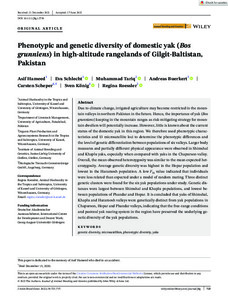Phenotypic and genetic diversity of domestic yak (Bos grunniens) in high-altitude rangelands of Gilgit-Baltistan, Pakistan
| dc.date.accessioned | 2022-10-24T10:15:29Z | |
| dc.date.available | 2022-10-24T10:15:29Z | |
| dc.date.issued | 2022-07-04 | |
| dc.identifier | doi:10.17170/kobra-202210247020 | |
| dc.identifier.uri | http://hdl.handle.net/123456789/14211 | |
| dc.language.iso | eng | |
| dc.rights | Namensnennung-Nicht-kommerziell 4.0 International | * |
| dc.rights.uri | http://creativecommons.org/licenses/by-nc/4.0/ | * |
| dc.subject | genetic diversity | eng |
| dc.subject | microsatellites | eng |
| dc.subject | phenotypic diversity | eng |
| dc.subject | yaks | eng |
| dc.subject.ddc | 570 | |
| dc.subject.ddc | 590 | |
| dc.title | Phenotypic and genetic diversity of domestic yak (Bos grunniens) in high-altitude rangelands of Gilgit-Baltistan, Pakistan | eng |
| dc.type | Aufsatz | |
| dcterms.abstract | Due to climate change, irrigated agriculture may become restricted in the mountain valleys in northern Pakistan in the future. Hence, the importance of yak (Bos grunniens) keeping in the mountain ranges as risk-mitigating strategy for mountain dwellers will potentially increase. However, little is known about the current status of the domestic yak in this region. We therefore used phenotypic characteristics and 13 microsatellite loci to determine the phenotypic differences and the level of genetic differentiation between populations of six valleys. Larger body measures and partially different physical appearance were observed in Shimshal and Khaplu yaks, especially when compared with yaks in the Chapurson valley. Overall, the mean observed heterozygosity was similar to the mean expected heterozygosity. Average genetic diversity was highest in the Hopar population and lowest in the Haramosh population. A low FIS value indicated that individuals were less related than expected under a model of random mating. Three distinct genetic clusters were found for the six yak populations under study. Genetic distances were largest between Shimshal and Khaplu populations, and lowest between populations of Phandar and Hopar. It is concluded that yaks of Shimshal, Khaplu and Haramosh valleys were genetically distinct from yak populations in Chapurson, Hopar and Phandar valleys, indicating that the free-range conditions and pastoral yak rearing system in the region have preserved the underlying genetic diversity of the yak populations. | eng |
| dcterms.accessRights | open access | |
| dcterms.creator | Hameed, Asif | |
| dcterms.creator | Schlecht, Eva | |
| dcterms.creator | Tariq, Muhammad | |
| dcterms.creator | Buerkert, Andreas | |
| dcterms.creator | Scheper, Carsten | |
| dcterms.creator | König, Sven | |
| dcterms.creator | Roessler, Regina | |
| dc.relation.doi | doi:10.1111/jbg.12730 | |
| dc.subject.swd | Gilgit-Baltistan | ger |
| dc.subject.swd | Pakistan | ger |
| dc.subject.swd | Shimshāl | ger |
| dc.subject.swd | Yak | ger |
| dc.subject.swd | Domestikation | ger |
| dc.subject.swd | Genetische Variabilität | ger |
| dc.subject.swd | Satelliten-DNS | |
| dc.subject.swd | Heterozygotie | |
| dc.type.version | publishedVersion | |
| dcterms.source.identifier | eissn:1439-0388 | |
| dcterms.source.issue | Issue 6 | |
| dcterms.source.journal | Journal of Animal Breeding and Genetics | eng |
| dcterms.source.pageinfo | 723-737 | |
| dcterms.source.volume | Volume 139 | |
| kup.iskup | false |
Dateien zu dieser Ressource
Das Dokument erscheint in:
-
Artikel [1238]


